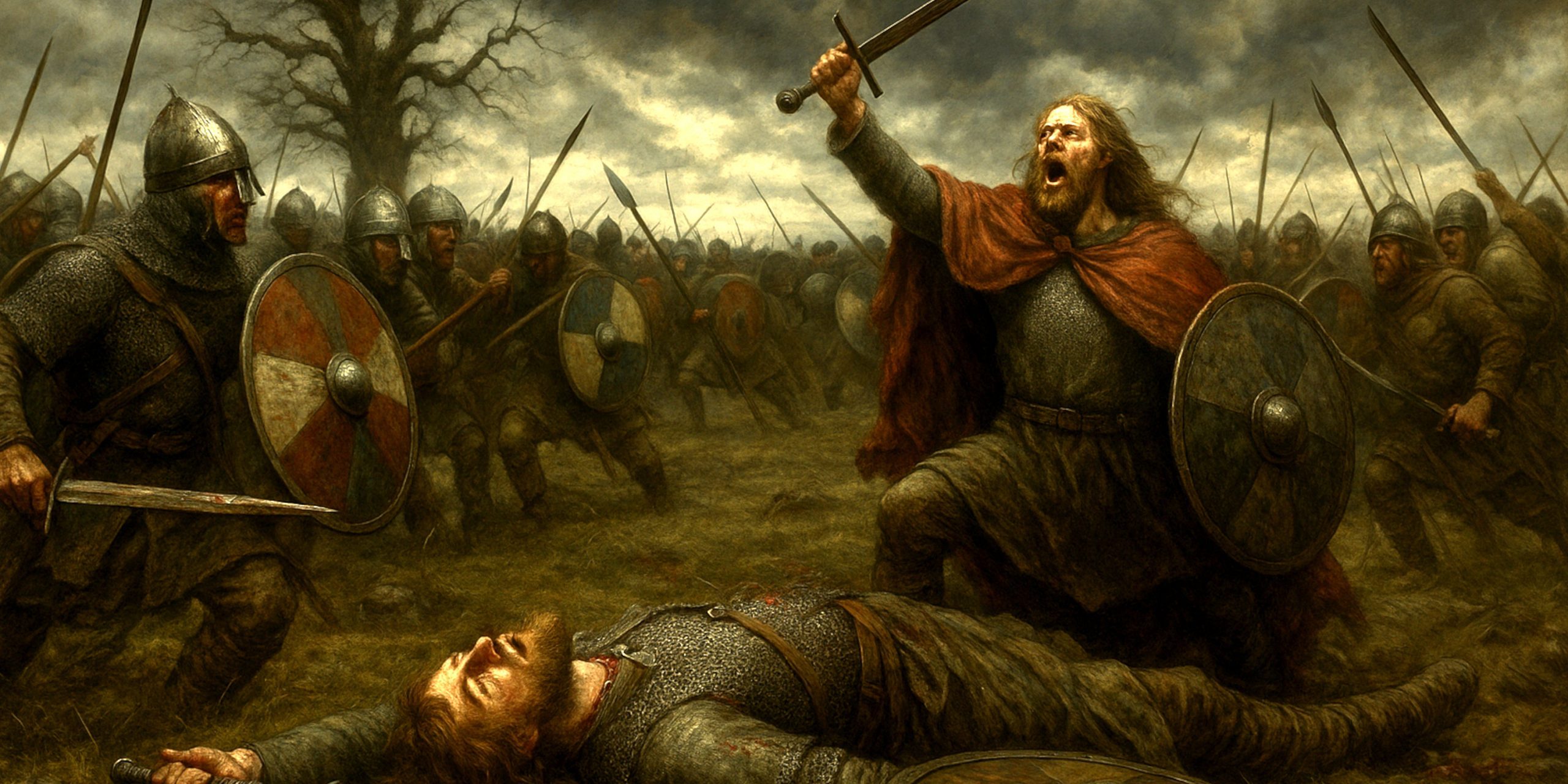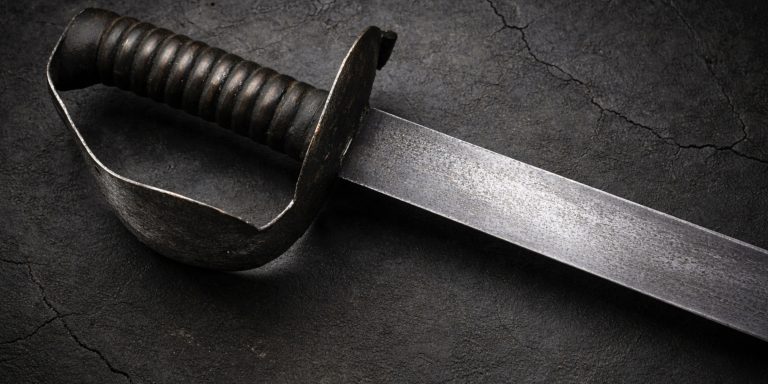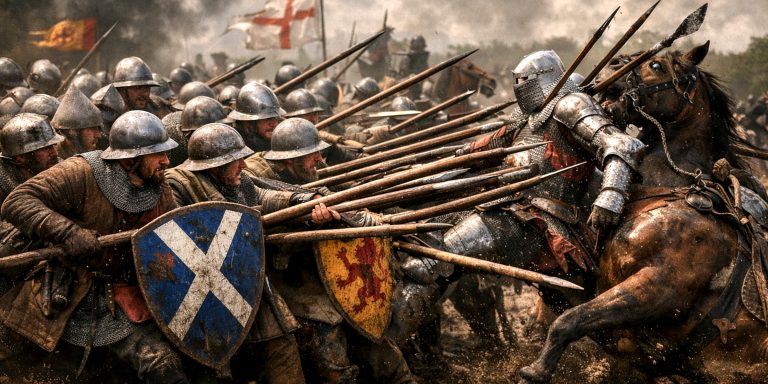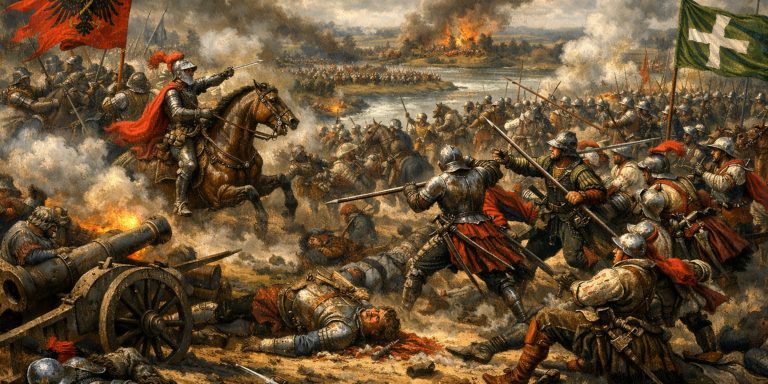
A clash soaked in ambition, vengeance, and blood, the Battle of Maserfield was a defining moment of early Anglo-Saxon England. It pitted the Christian king Oswald of Northumbria against the pagan Penda of Mercia, two men whose enmity shaped the political and religious landscape of the 7th century. The result was brutal, final, and, in many ways, symbolic of the violent birth of an English identity still being carved from tribal loyalties
In 642 AD, near the town now called Oswestry in Shropshire, two kings met in battle. Oswald of Northumbria, famed for his piety and once hailed as “Bretwalda” (overlord of Britain’s southern kingdoms), faced the unyielding Penda of Mercia, whose ferocity and disdain for Northumbrian dominance made him both feared and admired. The result was Oswald’s death and dismemberment, a grim end that turned him from king to saint almost overnight.
The chroniclers, particularly Bede, recount the event with a mixture of horror and reverence, suggesting that even the soil of Maserfield became sacred by the blood of the fallen king. Today, Oswestry’s name itself hints at this legacy, Oswald’s Tree, where his body was supposedly displayed after the battle.
Forces
Despite the limited written record, historians can make educated estimates of the opposing armies. Both were composed largely of seasoned warriors drawn from regional thegns and their retinues, bolstered by levies of freemen eager for plunder or bound by allegiance.
| Kingdom | Commander | Estimated Strength | Key Allies | Notes |
|---|---|---|---|---|
| Northumbria (Bernicia & Deira) | King Oswald | 2,500–3,000 men | Possibly Welsh allies from Powys or Rheged | Christian army, disciplined, seasoned from prior campaigns |
| Mercia | King Penda | 3,000–3,500 men | Welsh kingdom of Gwynedd under King Cadafael | Predominantly pagan, fierce and mobile warriors |
Oswald’s forces were likely outnumbered and may have been caught off guard while campaigning south into disputed territory. Penda’s use of local support and his alliance with Welsh rulers gave him a decisive advantage in both intelligence and terrain.
Leaders and Troop Composition
Northumbria (Oswald’s Host):
- Leader: King Oswald of Northumbria
- Core Troops: Northumbrian hearthweru (royal household guard)
- Infantry: Anglian spearmen with round shields and mail coats
- Cavalry: Light horsemen used for flanking and pursuit
- Missile Troops: Javelin throwers and a handful of archers, though archery was still a minor feature of warfare in this period
Mercia (Penda’s Host):
- Leader: King Penda of Mercia
- Core Troops: Mercian comitatus – elite pagan warriors sworn to personal loyalty
- Infantry: Heavily armed spear and axe bearers, often fighting in close shield-walls
- Cavalry: Limited but effective in pursuit and scouting roles
- Allies: Welsh troops from Gwynedd, skilled in guerrilla fighting and familiar with the local terrain
Arms and Armour
The 7th century was an age of transition between heroic warrior tradition and organised kingdom warfare. The equipment reflected both inherited Germanic craftsmanship and rising Anglo-Christian wealth.
| Type | Description | Notable Use |
|---|---|---|
| Swords | Pattern-welded double-edged blades (around 80–90 cm). Northumbrians favoured the spatha, often with decorated hilts. Penda’s men may have carried heavier continental-style swords. | Close combat, duelling, and status symbol |
| Spears | The most common weapon, with leaf-shaped iron heads. Some had angons (barbed throwing spears). | Main weapon of the shield-wall |
| Axes | Broad-bladed axes used by Mercian infantry for breaking shield-walls. | Favoured by Penda’s warriors |
| Shields | Round, with iron bosses and painted leather surfaces. | Core defence and identity marker |
| Helmets | Conical iron or bronze helms, sometimes with mail aventails. | Elite warriors only |
| Mail Coats | Worn by nobles and thegns. Ordinary soldiers wore leather jerkins. | Northumbria’s upper ranks more likely equipped |
Archaeological parallels from Sutton Hoo and Staffordshire Hoard finds suggest both armies were as glittering as they were deadly. Ornamented sword pommels and gold-inlaid hilts remind us that even in death, rank mattered.
Archaeology
While Maserfield’s exact site remains debated, most scholars place it near Oswestry Hillfort or the nearby Maesbury Marsh. Excavations in the area have revealed:
- Anglo-Saxon weapon fragments, including spearheads and shield bosses.
- Roman-era reuse of roads and defensive sites, hinting at the battle’s strategic placement.
- Local toponyms referencing Oswald’s death, such as “Oswald’s Well”, believed to mark where he fell praying for his men.
The lack of a mass grave contrasts with the battle’s reputed ferocity, though this might be due to later veneration of the site, Oswald’s remains were dismembered, relics scattered to churches across Northumbria and the continent.
Battle Timeline
| Time | Event |
|---|---|
| Early 642 AD | Oswald marches south into Mercian-held territory, perhaps to reassert dominance or defend allied Welsh lands. |
| Morning, Battle Day | Oswald’s army positions on open ground near Oswestry. Penda’s forces arrive with Welsh contingents on the flank. |
| Midday Clash | Shield-walls engage. Northumbrians hold initial advantage due to discipline and heavy mail. |
| Afternoon | Welsh allies of Penda strike the Northumbrian flank. Chaos ensues. Oswald is surrounded. |
| Oswald’s Death | According to Bede, Oswald prays for his men before being cut down. His body is mutilated and displayed on a tree. |
| Aftermath | Penda solidifies Mercian dominance across central England. Oswald becomes venerated as a saint, his relics distributed far and wide. |
Contemporary Quotes
Bede, in his Ecclesiastical History, writes:
“Oswald fell in a great battle, fighting for his people, and praying for their souls as he died.”
The Historia Brittonum offers a more pagan-flavoured view:
“Penda and the heathen slew Oswald, king of the Northumbrians, and he fell in the field of Maserfelth.”
Both agree on one point, Oswald’s death changed everything.
Legacy
Maserfield marked the end of Northumbrian supremacy and the rise of Mercia as the dominant English power. Penda’s victory ensured that paganism would persist in central England for another generation. Yet in a twist of irony, Oswald’s martyrdom achieved what his sword could not, it united faith and legend.
Pilgrims later flocked to sites bearing his name, from Northumbria to Bavaria, where relics of his arm were claimed to perform miracles. Penda, on the other hand, left no relics and no sainthood, but his reputation as England’s last great pagan warlord endures.
It is said that “Oswald’s Tree” grew from the spot where his arm was hung, its roots nourished by royal blood and stubborn faith, a fitting metaphor for a kingdom still struggling between sword and soul.
Author’s Note
As a historian, one cannot help but admire the sheer theatricality of Maserfield. It reads like a morality play with too much steel. Oswald prays, Penda curses, and history chooses both, the saint and the sinner, forever bound in the same blood-soaked field.
Watch the documentary:



